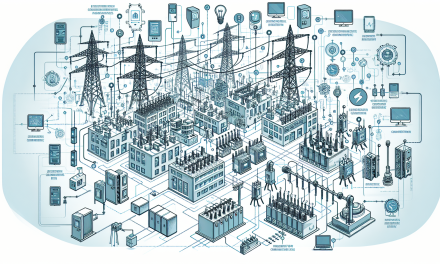Table of Contents
- Introduction
- Understanding Energy Audits
- The Importance of Energy Management
- Essential Skills and Knowledge in Energy Management
- Steps Involved in Conducting an Energy Audit
- Benefits of Implementing Energy-Efficient Practices
- Investing in Your Energy Management Knowledge
- Frequently Asked Questions
- Conclusion
Introduction
Energy efficiency stands as a vital aspect of modern industrial and commercial practices. Many organizations aim to reduce energy consumption to benefit the environment and improve their bottom line. Therefore, understanding energy audits and effective management practices has never been more crucial.
By mastering energy audit techniques and management strategies, individuals can unlock immense savings and sustainability opportunities for their organizations. In this exploration, we will delve into the intricate world of energy audits and management, highlighting their importance and how they can lead to significant shifts in energy consumption patterns.
Understanding Energy Audits
Energy audits act as a comprehensive examination of energy consumption within a facility. They evaluate how energy is utilized and provide recommendations for improvement. Essentially, an energy audit encompasses three primary stages:
- Preliminary audit
- Detailed audit
- Follow-up audit
During the preliminary audit, assessors gather data on energy bills, usage patterns, and previous energy efficiency measures implemented. Subsequently, the detailed audit involves a thorough on-site inspection to identify energy-saving opportunities. Lastly, the follow-up audit ensures that the recommended strategies have been executed and evaluates their effectiveness.
The Importance of Energy Management
Effective energy management contributes significantly to reducing operational costs, enhancing productivity, and minimizing environmental impact. In fact, it provides a competitive edge in today’s market. As sustainability continues to rise in importance, organizations equipped with robust energy management practices can lead in their respective industries.
Feedback from organizations demonstrates that energy management not only leads to cost savings but also fosters a culture of sustainability. Employees become more aware of energy usage, leading to collective efforts to create a greener workspace.
Driving Sustainability and Compliance
In addition to economic benefits, energy management aligns with sustainability goals. Governments and regulatory bodies are increasingly imposing regulations to reduce energy consumption. Thus, effective energy management assists organizations in meeting compliance requirements while striving for sustainability.
Essential Skills and Knowledge in Energy Management
Determining energy efficiency necessitates a distinct set of technical skills and knowledge. Professionals in this field should cleanly grasp concepts related to energy systems, regulations, and renewable energy options. Additionally, proficiency in data analysis empowers individuals to draw actionable insights from energy consumption patterns.
Moreover, skills in communication and project management prove invaluable. Implementing new energy management practices often involves collaboration across various departments. Thus, the ability to convey ideas clearly and lead projects to fruition cannot be overstated.
Renewable Energy Knowledge
Acquiring knowledge about renewable energy sources greatly enhances energy management strategies. Innovations in renewable energy, such as solar and wind power, present fantastic opportunities for sustainability. Discover more about integrating renewables in your strategy here: Unlocking the Power of Renewable Energy: Essential Insights and Knowledge.
Steps Involved in Conducting an Energy Audit
Implementing an energy audit involves several key steps, each critical to achieving favorable outcomes. Here’s a straightforward approach to conducting an energy audit:
1. Define Objectives and Scope
Understanding the purpose of the audit lays the groundwork. Whether aiming for compliance, sustainability, or cost reduction, clear objectives guide the audit process.
2. Gather Data
Start collecting relevant data, including utility bills, past audit reports, and operational benchmarks. This data provides a baseline against which improvements can be measured.
3. Conduct Walkthrough Analysis
A walkthrough analysis allows for a preliminary assessment of energy utilization practices. This stage identifies obvious inefficiencies.
4. Analyze Data
Using energy management software or analytical tools can significantly aid in this phase. Data analysis uncovers trends and anomalies critical for informed decision-making.
5. Implement Recommendations
After developing a list of actionable recommendations, put them into practice. Consider prioritizing based on the potential for savings versus upfront costs.
6. Monitor Performance
Implement a robust performance monitoring system to track the effectiveness of the measures taken. This stage ensures that the benefits of the energy audit remain long-term.
Continuous Improvement
Establishing a culture of continuous improvement fosters ongoing evaluations and adjustments in energy practices.
Benefits of Implementing Energy-Efficient Practices
Engaging in energy-efficient practices yields numerous advantages, both for individual organizations and the environment. Here are some key benefits:
- Reduced Costs: Lower energy consumption directly affects utility bills, resulting in significant savings.
- Enhanced Comfort: Improved energy systems create a more comfortable working environment, boosting employee productivity.
- Environmental Impact: Decreasing energy use contributes to lower greenhouse gas emissions, promoting a cleaner environment.
- Competitive Edge: Organizations that prioritize energy efficiency enjoy positive public perception and can even command higher prices for sustainable practices.
- Regulatory Compliance: Efficient energy management positions organizations to stay ahead of legal regulations related to energy consumption.
Investing in Your Energy Management Knowledge
If you’re looking to deepen your understanding of energy audits and management, professional training is invaluable. Gaining certifications can greatly enhance your career prospects while equipping you with practical skills applicable in diverse industries. For more in-depth training, consider this resource: Energy Audit & Management Certification Training Course.
Furthermore, keeping abreast of trends and technologies in energy management is crucial. Reading articles such as Exploring the Impact and Benefits of Renewable Energy Sources in Today’s World ensures you remain informed about emerging practices and innovations.
Frequently Asked Questions
What qualifications do I need to conduct an energy audit?
While specific qualifications vary by organization and industry, having a background in engineering, environmental science, or energy management is beneficial. Certifications in energy auditing also enhance credibility.
How often should an energy audit be conducted?
Regular audits are advisable. Many organizations opt for annual audits, while others may conduct them bi-annually or every few years, depending on operational changes and improvements made.
What are common challenges in implementing energy-efficient practices?
Resistance to change and upfront costs can pose significant challenges. However, demonstrating the long-term financial and environmental benefits can mitigate these challenges.
Conclusion
Investing time and effort into understanding energy audits and management pays off significantly. Not only do these practices lead to considerable energy savings and increased efficiency, but they also foster sustainable organizational cultures. In today’s energy-conscious world, being well-versed in energy management is more important than ever. By taking these steps, you position yourself—and your organization—for long-term success in a rapidly evolving landscape.





